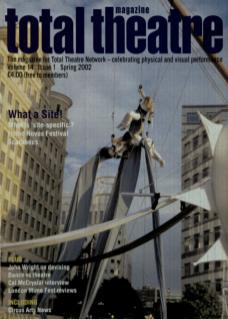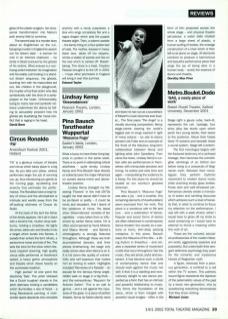What a luxury to have these living legends in London in the same week. There is no point in attempting critical aloofness – quite simply, Lindsay Kemp and Pina Bausch have directly or indirectly been the major influences on current dance-mime and dance-theatre practice.
Lindsay Kemp changed my life: seeing Flowers in the mid 1970s taught me that dance didn't have to be po-faced or pretty – it could be ironic and decadent. And I learnt of the existence of mime. His latest show Dreamdances consists of ten vignettes – many taken from or influenced by earlier Kemp works. He is often accompanied by Nuria Moreno and Marco Berriel – and Berriel's choreography is strongly featured throughout. Although these are both accomplished dancers, and their pieces entertaining, the stage only really comes alive when Kemp is on it. It is his clown-like quality of vulnerability and self-exposure that makes him so riveting to watch. Highlights included ‘Memories of a Traviata’ – an excuse for the famous Kemp angst-ridden walk on stage in a big frock – and the extraordinary ‘Requiem for Antonio Salieri’. This is an ode to genius – and a rail against the injustices of the gods. In a piece of perfect theatre, Kemp as Salieri silently rants and tears his hair out as a soundtrack of Mozart's music becomes ever louder... The final piece 'The Angel’ is a visually stunning composition; Kemp stage-centre wearing the world's biggest pair of wings washed in light of many colours – an ode to dance pioneer Lois Fuller and an example of the fruits of the fabulous long-term collaboration between Kemp and lighting artist John Spradbery. Then came the bows. Lindsay Kemp's curtain calls are performances in themselves with immaculate precision and timing, he enters and exits time and again – manipulating the audience to a frenzy. For this alone he should be lauded as our country's greatest showman.
Pina Bausch's Masurca Fogo was also a joy – and a surprise. Any remaining elements of Ausdruckstanz seem exorcised from her work. This piece is a wondrous ode to life and love – and a celebration of dance. Popular and social forms of dance are often referenced in contemporary dance-theatre: but usually as a pastiche or ironic, skin-deep passing metaphor. In this piece, Bausch takes the Masurca of the title – a lilting rhythm in three/four – and creates a repeated series of movement motifs that recur throughout: like the music, they are lyrical, joyful and exuberant. It has become such a cliché of contemporary dance that one should work against the music not with it that it is a startling and revolutionary delight to see dance presented as a form that has an intrinsic and powerful relationship to music. This forms the foundation of the piece, which is then merged with powerful visual images – often in the form of film projected across the whole stage – and physical theatre set-pieces: a water slide created from a large sheet of plastic, a human surfing of bodies, the onstage construction of a chair which is then left to sit alone on stage. All elements combine to produce a harmonious and beautiful performance piece that sings the joy of being alive in a human body – surely the essence of dance and theatre.

